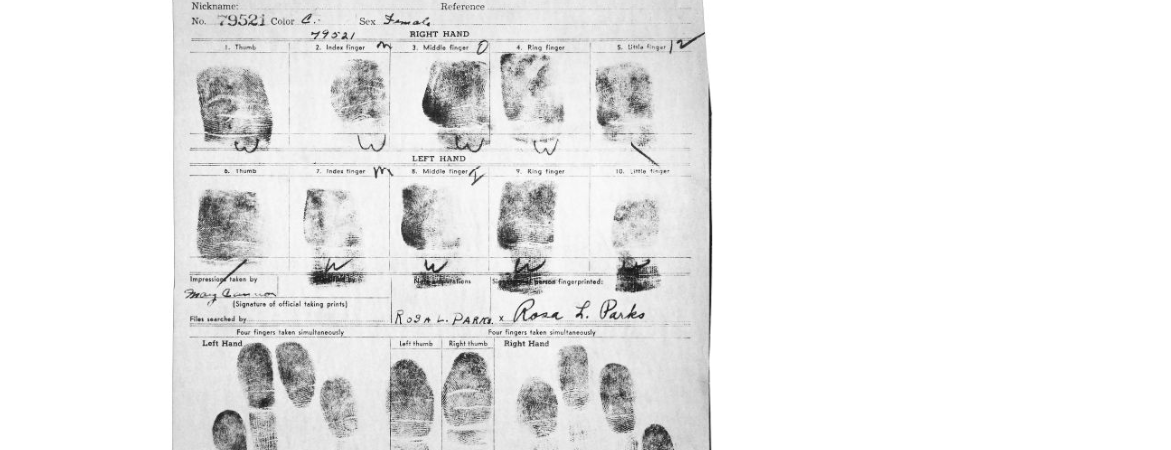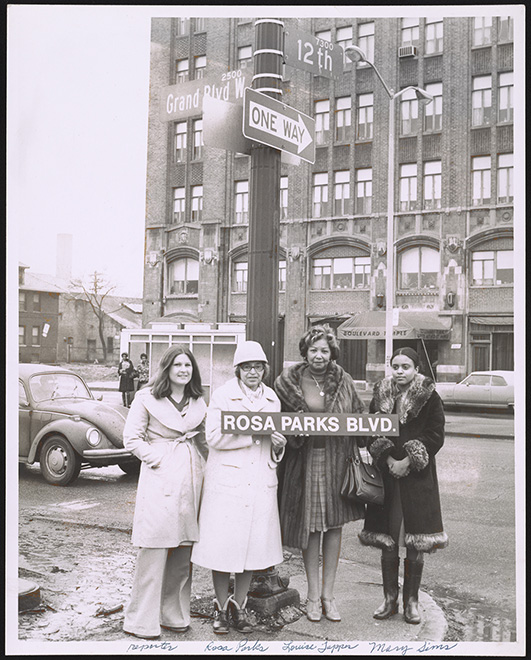On December 1, 1955, Mrs. Rosa Parks (born McCauley), a seamstress at the Montgomery Fair department store in Montgomery, Alabama, left the store to go back home, getting on a bus and taking the only remaining vacant seat next to the aisle, in the front row of the “colored” section. At the third stop, when the bus driver pulled up to the side of the Empire Theater, a number of white passengers entered the bus and the “lily-white” section became full. One white man had to remain standing. The bus driver J.S. Blake requested from the first-row passengers of the colored section: “You let him have those front seats!” When none of the black passengers moved when first called upon, the bus driver reiterated his request, this time more firmly: “You all better make it light on yourselves and let me have those seats.” Three of the four passengers stood up, but Mrs. Parks didn’t. The bus driver then came down the aisle to go in Mrs. Parks’ direction and asked her if she was going to get up, but Mrs. Parks replied “No.” “I’m going to have you arrested,” the driver said. “You may do that,” she answered. Two white policemen arrived. She asked one of them, “Why do you all push us around?” He answered, “I don’t know, but the law is the law and you’re under arrest.” The police took her to the jail where she was fingerprinted, photographed and booked.
 Rosa Parks' fingerprints image courtesy of the National Archives
Rosa Parks' fingerprints image courtesy of the National Archives
E.D. Nixon, who had been a community leader in many civil rights causes in Montgomery, bailed her out of jail. He was the former head of the Montgomery branch of the National Association for the Advancement of Colored People (1946-50) and former head of the state NAACP conference (1947-1949); Parks had worked with him for a dozen years in the NAACP. Indeed, Rosa Parks was a civil rights activist who had been one of the first women in Montgomery to join the NAACP, serving as the secretary of the Montgomery branch and having also been involved in the Alabama State branch. She was fully aware of the consequences her refusal to stand up to leave her seat on the bus could have entailed. She knew of numerous previous cases where black passengers had been beaten or even shot by the police or bus drivers when they were unwilling to comply with the segregation laws on public transportation. She had herself confronted bus segregation laws in the past since “she had refused to put her fare in the front fare box and go around to the back door to reenter the bus.”
Nixon asked Parks that night for permission to use her bus arrest as a case to measure the constitutionality of the local city bus ordinance: “The policy of the Montgomery City Lines bus company was written in keeping with city and state ordinances on segregation. Drivers were to designate the front part of the bus for whites and the rear section for blacks in proportion to the number of blacks and whites on the bus at any given moment. As more whites came onto the bus, the driver moved an imaginary color line further to the rear of the bus. Blacks, sitting directly behind the ‘whites-only’ section, would be ordered to move further toward the rear of the bus, if whites had to stand. The official policy, theoretically, was that if there were no vacant seats available behind the imaginary color line, blacks did not have to stand for whites to sit. But, in practice, whenever a white person had to stand, the driver would look in the rear view mirror and yell at the ‘Nigras’ to move to the back of the bus, even if there were no vacant seats.” The racist system on buses had been an issue for many years, with women making “all of the litigants who challenged the racist system, in the courts” – since most of the black passengers on buses in Montgomery were women, this isn’t surprising. Nixon had previously tried to find a representative case to question the legality of the city bus practices. However, he had never found a case or a person he believed solid enough for the black community of Montgomery to coalescence around to attempt a confrontation of the city buses. However, with Parks, he thought that he had a powerful person to rely on, since she was highly known and respected in the black community of Montgomery. After much thought and a discussion with her husband, Parks agreed to have Nixon use her case and name to support the battle for an integrated public transportation system.
In fact, preparation to organize a bus boycott in Montgomery had already begun many months before through other members of the black community, specifically, at the Women’s Political Council (WPC), which was formed in 1949 after Jo Ann Gibson Robinson, a professor at Alabama State College, was forced to leave an almost empty bus when she refused to move to the back. The WPC also considered the arrest of Parks as the appropriate event to set a boycott in motion. With the help of two of her senior students, Robinson printed out leaflets with their college’s mimeograph equipment in the middle of the night from December 1st to December 2nd asking every black person to stay off the Montgomery buses on Monday December 5, 1955, the day of Rosa Parks’ trial, as a protest of the trial. By the evening of December 2nd, many Black citizens of Montgomery had already received the leaflet. Nixon had worked hard on the morning of December 2nd to reach out to local leaders in the black community – first turning to the churches. A group of these preachers decided to organize a meeting that evening:
“More than 50 people met in the basement of Dexter Avenue Baptist church. They represented every segment of the black community: ministers, doctors, lawyers, businessmen, teachers (primarily from Alabama State College), unskilled and semi-skilled laborers, students, heads of political, professional and social clubs, men and women, all were represented.” Parks was also present and told everyone what had happened to her. The group’s members, while not of the same mind about all different matters discussed that evening, agreed that a form of collective action had to take place and outlined some measures that had to be taken to ensure that the widest audience possible would be reached in the black community. These measures included, among others: telling everyone in the black community what had happened to Parks on the bus; asking everyone to support the bus boycott on Monday; and that the bus boycott would be the only sermon delivered by the ministers on Sunday, December 4.
 Dedication of Rosa Parks Blvd in Detroit, July 1967 image courtesy of Library of Congress
Dedication of Rosa Parks Blvd in Detroit, July 1967 image courtesy of Library of Congress
The boycott was an immense success: “Scarcely any African Americans rode the buses on Monday, December 5.” At the sight of this first day’s success, the leaders of the black community then formed a new entity, the Montgomery Improvement Association (MIA), and chose Dr. Martin Luther King Jr. as their leader. On a mass meeting at Holt Street Baptist Church on December 5, they decided to pursue the boycott – a boycott that, in the end, would end up lasting for three hundred and eighty-one days. During the boycott, African Americans carpooled or walked to work, to run errands, or to attend their other daily activities, while facing harassment and bullying or even the loss of their jobs. In February 1956, the MIA filed a lawsuit in federal district court challenging the constitutionality of bus segregation. In June, the court ruled in favor of the MIA, but the city appealed the decision to the Supreme Court which, on November 13, 1956, upheld the district court’s ruling that bus segregation violated the equal protections clauses of the 14th amendment. The city officials of Montgomery challenged the ruling again but were unsuccessful.
Dr. Roberta Hughes Wright writes eloquently about the MIA’s great commitment in this context:
“The boycott, already 343 days old at that time, could have been called off. In a magnificent display of dedication and discipline, the members of MIA continued the boycott for another 38 days until the federal decree reached Montgomery. The written mandate arrived in Montgomery on December 20, and on December 21, 1956, nearly thirteen months from the start, blacks returned to the buses.”
RESEARCH & WRITING
Louise-Helene Filion, Ph.D.
PHOTO RESEARCH
Rebecca Phoenix
Bibliography:
Burns, Stewart. Daybreak of Freedom. The Montgomery Bus Boycott, Chapel Hill and London, The University of North Carolina Press, 1997, 359 p.
Parks, Rosa (with Jim Haskins). Rosa Parks: My Story, New York, Dial Books, 1992, 192 p.
“Rosa Parks and the Montgomery Bus Boycott,” Celebrating Martin Luther K. Jr. (at Wesleyan University), https://www.wesleyan.edu/mlk/posters/rosaparks.html . Accessed 2 February 2022.
“The Bus Boycott,” Rosa Parks: In Her Own Words (exhibit/Library of Congress), https://www.loc.gov/exhibitions/rosa-parks-in-her-own-words/about-this-exhibition/the-bus-boycott/ . Accessed 2 February 2022.
Wright, Dr. Roberta Hughes. The Birth of the Montgomery Bus Boycott, Southfield (Michigan), Charro Book Co., Inc., 1991, 158 p.
- Dr. Roberta Hughes Wright, The Birth of the Montgomery Bus Boycott, Southfield (Michigan), Charro Book Co., Inc., 1991, p. 2.
- Ibid.
- Rosa Parks (with Jim Haskins), Rosa Parks: My Story, New York, Dial Books, 1992, p. 1.
- Ibid.
- Ibid.
- Ibid.
- Dr. Roberta Hughes Wright, The Birth of the Montgomery Bus Boycott, op. cit., p. 1.
- Ibid., p. 27.
- Ibid., p. 27.
- Ibid., p. 37.
- “Rosa Parks and the Montgomery Bus Boycott,” Celebrating Martin Luther K. Jr. (at Wesleyan University), https://www.wesleyan.edu/mlk/posters/rosaparks.html. Accessed 2 February 2022.
- Dr. Roberta Hughes Wright, The Birth of the Montgomery Bus Boycott, op. cit., p. 52.
- Ibid.
- Ibid., p. 53.
- Stewart Burns, Daybreak of Freedom. The Montgomery Bus Boycott, Chapel Hill and London, The University of North Carolina Press, 1997, p. 10.
- Dr. Roberta Hughes Wright, The Birth of the Montgomery Bus Boycott, op. cit., p. 119.


